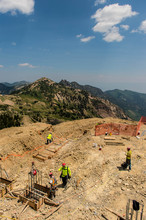This is an archived article that was published on sltrib.com in 2014, and information in the article may be outdated. It is provided only for personal research purposes and may not be reprinted.
Save Our Canyons wants the U.S. Forest Service to stop Snowbird Ski & Summer Resort from proceeding with excavation work for a restaurant on top of Hidden Peak.
The conservation organization contends Snowbird has made enough changes to its mountain-development plans in the 15 years since the Forest Service approved the controversial structure to warrant an updated environmental study.
"An agency that has prepared an EIS [environmental impact statement] cannot simply rest on the original document," Save Our Canyons Executive Director Carl Fisher said in a letter Wednesday to the Forest Service. "The agency must be alert to new information that may alter the results of its original environmental analysis."
Cathy Kahlow, the Forest Service's Salt Lake District ranger, said Thursday she could not comment on the group's demand for more environmental analysis until her staff analyzes it more thoroughly.
"We're trying to understand what they feel is not correct and make a determination about whether they're right or not," she said. "It's too soon to give you any feedback on that."
After a lengthy fight, the Forest Service approved Snowbird's plans in 1999 to construct a scaled-back restaurant on the 11,000-foot peak, adjacent to the top terminal of the aerial tram that carries riders up from the resort's base facilities.
Limited physical work has occurred there until this spring — about the time Snowbird co-founder Dick Bass announced he was selling majority interest in the resort to businessman Ian Cumming, whose many holdings include Powdr Corp., parent company of Park City Mountain Resort.
Kahlow said she authorized Snowbird in May to begin excavating a foundation for the building. Approval to start construction awaits the completion of a review by the agency's regional engineers.
"We expect that any day," she added.
With Forest Service authorization in hand, Snowbird has obtained grading and building permits from Salt Lake County, the county's only involvement in the regulatory process.
"Our ordinances don't apply to that [Hidden Peak] structure," said county planning and development division director Rolen Yoshinaga. "We inspect the [grading] work to make sure they have all of their management practices in place to keep silt and things like that from coming off the construction site. We've seen no inspection failure of any kind."
Now Snowbird is looking to a fall 2015 opening of a 23,000-square-foot building with panoramic views of the Wasatch Mountains, a restaurant, restrooms and ski-patrol offices.
"Anyone who has ridden the tram to Hidden Peak realizes this is a much-needed facility to serve our year-round guests," said Snowbird President Bob Bonar.
"The building's design and functionality have been through lengthy reviews with Salt Lake County, the Forest Service and other agencies and have received approvals from these agencies."
Although little has happened on Hidden Peak since '99, numerous developments elsewhere in the resort drive the need for a second look, Save Our Canyons' Fisher said.
He cited major amendments Snowbird proposed to its master plan in 2010, in particular the "conceptual" notion of extending another tram from Hidden Peak to American Fork Twin Peaks. That lift would provide access to Mary Ellen Gulch on Snowbird's back side, adjacent to Mineral Basin.
This proposal, Fisher wrote, is a "significant change of circumstances that requires the Forest Service to conduct supplemental [environmental] review" because the mountaintop facility would be a connecting point to reach American Fork Twin Peaks.
A review of Hidden Peak, he said, should be part of a detailed analysis of the American Fork Twin Peaks/Mary Ellen Gulch proposal. Snowbird has not yet submitted that proposal.
mikeg@sltrib.com Twitter: @sltribmikeg







